Duke, Arizona Headline the Top 50 Offenses in College Basketball

Sports Illustrated’s 2017–18 college basketball projections are a collaboration between economist Dan Hanner, SI’s Chris Johnson and SI’s Jeremy Fuchs. The system uses college and AAU statistics, recruiting rankings and coaching data to project every Division I player and team. For a deeper look at how the system works, read this explainer. SI’s ranking of teams 1–351 has been more accurate than similar 1–351 rankings produced by ESPN, CBS Sports and noted analyst Ken Pomeroy for three consecutive years.
In the next installment of our preview, we’re analyzing the best 50 offenses in the country. Our offensive efficiency ratings are based on the projected individual statistics for all 351 teams. You can check these out in our previews for the nation’s top nine conferences (American, ACC, Atlantic 10, Big East, Big Ten, Big 12, Mountain West, Pac-12 and SEC).
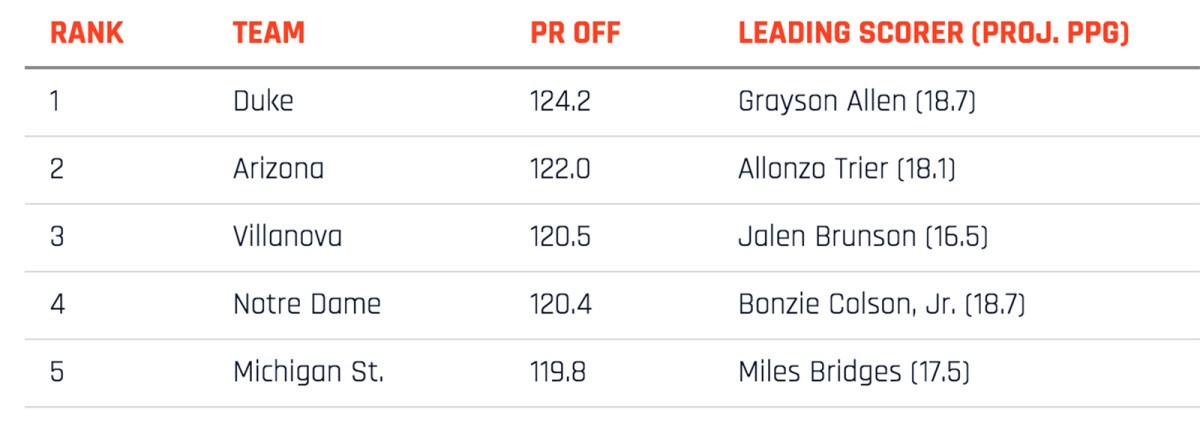
We’ll dive into this topic further in our “What if?” column later on in the preseason, but the addition of top recruit Marvin Bagley III lifted Duke to the No. 1 offensive projection. It’s fair to question how long the Blue Devils’ freshmen will need to learn how to play together, as well as whether they’ll have enough perimeter shooting. But Mike Krzyzewski has coached a top-10 offense for nine straight seasons, and as he showed when he emphasized post-bound center Jahlil Okafor on the squad that won it all in 2015, he’s adept at adjusting his system to accentuate the skills of his best offensive players. Villanova (No. 3) will be able to put up buckets in bunches even after losing Big East Player of the Year and first-round draft pick Josh Hart. Jalen Brunson is capable of scaling up his scoring while remaining efficient, and Donte DiVincenzo is a prime breakout candidate. The pieces change at Notre Dame (No. 4) every season, and Mike Brey keeps churning out high-end offenses despite the absence of five-star-stuffed recruiting classes to replace them. This season will be no different. Big Ten foes won’t have many defensive answers for National Player of the Year favorite Miles Bridges and the rest of the nation’s most formidable sophomore class at Michigan State (No. 5).
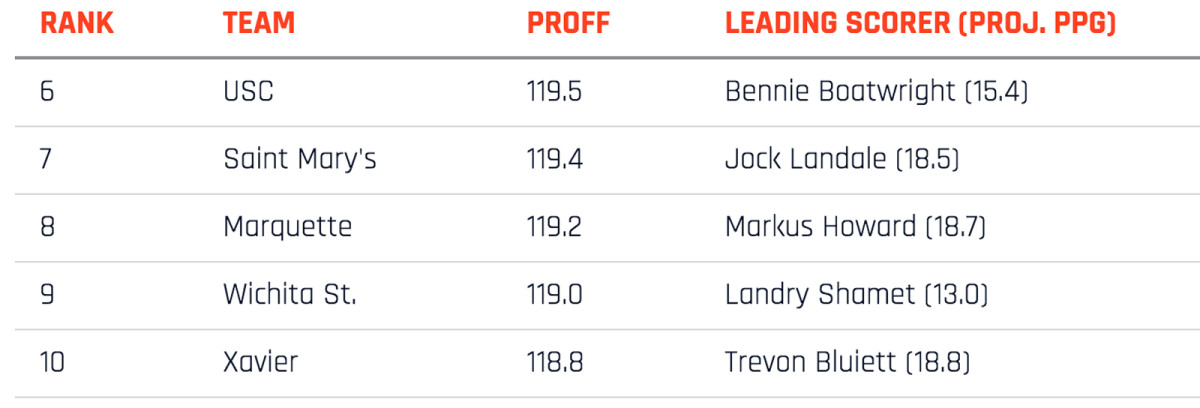
USC (No. 6) brought back every key contributor from the squad that won 26 games in 2016–17, including two projected first-round NBA draft picks in big man Chimezie Metu and guard De’Anthony Melton. Plus, it’ll have a former five-star PG recruit who transferred from Duke, Derryck Thornton, eligible to beef up the backcourt rotation. Jock Landale is a super-productive interior scorer, and Calvin Hermanson and Emmett Naar both drained more than 40% of their three-point attempts last season. That trio is the foundation of a Saint Mary’s (No. 7) offense that’ll shred West Coast Conference opponents. Wichita State (No. 9) won’t have Markis McDuffie early in the season while he rehabilitates a foot injury, but Landry Shamet’s scoring and facilitating will make the Shockers tough to guard even without him.
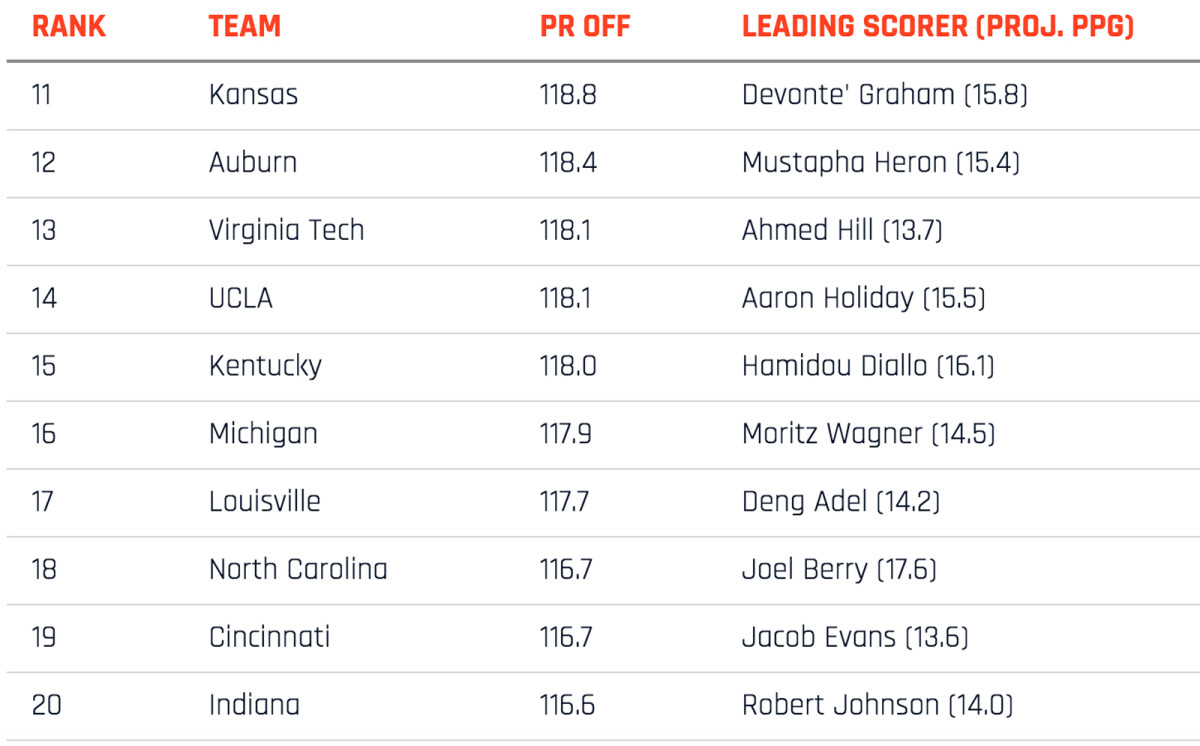
Kansas (No. 11) will reorient its offense around Devonte’ Graham without his dominant backcourt partner from last season, Frank Mason. The addition of Arizona State transfer Sam Cunliffe after the first semester will help. The Lonzo show has left the college game (although it’s staying in Los Angeles), along with several other pieces of the West Coast’s top offense last season, but Aaron Holiday can manage a larger portion of UCLA’s (No. 14) shots, and Thomas Welsh projects as one of the Pac-12’s most efficient frontcourt scorers. Joel Berry’s decision to return to North Carolina (No. 18) for one more season will stabilize an attack that lost three starters from its national championship starting lineup, even if he’s going to miss part of the Tar Heels’ non-conference schedule with a broken right hand.
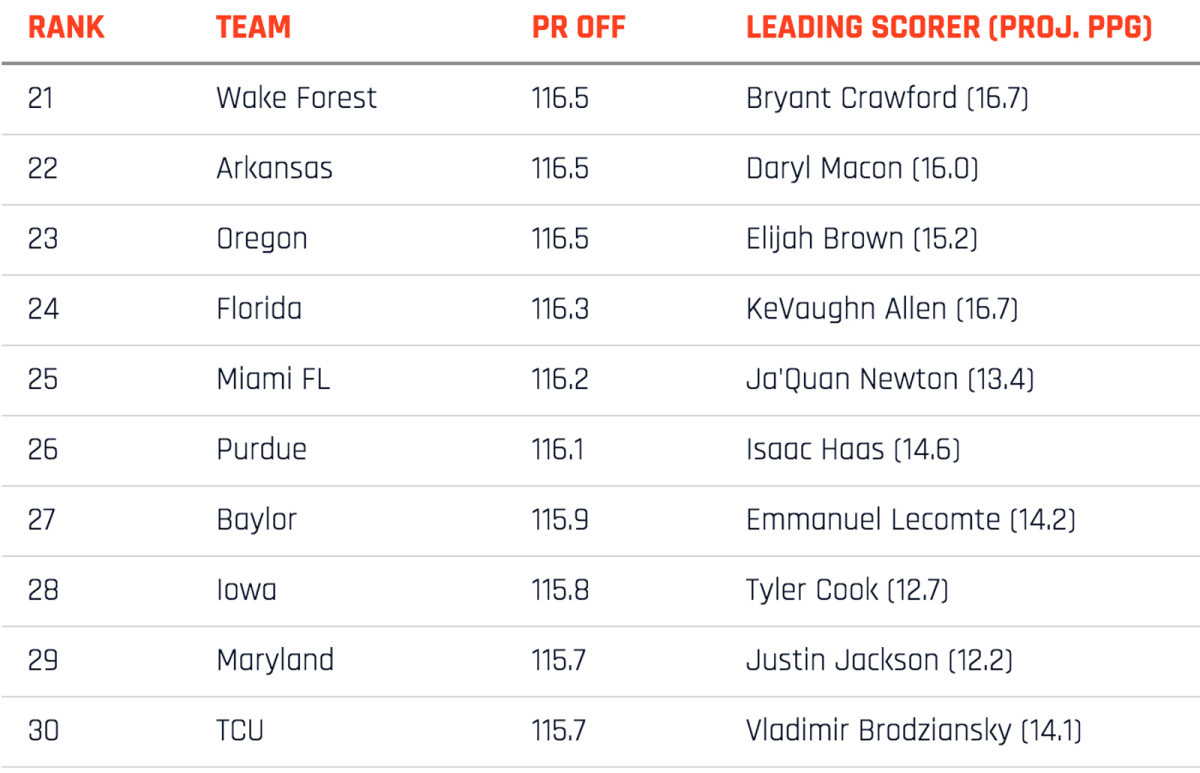
Oregon (No. 23) notched a major victory on the transfer market this offseason in Elijah Brown, a capable bucket-getter who made 36.3% of his long-range tries during previous stops at Butler (one season) and New Mexico (two seasons). Miami (No. 25) should have one of the better guard rotations in the country, although it could benefit from giving sophomore Bruce Brown more scoring opportunities at Ja’Quan Newton’s expense. Big man Dewan Huell averaged only 5.8 points per game last season, but he could blossom as a sophomore after arriving in Coral Gables as the nation’s No. 27 recruit, according to the RSCI. Guards Anthony Cowan and Kevin Huerter, as well as three-and-D wing Justin Jackson, can keep Maryland’s (No. 29) offense in the top half of the Big Ten without Melo Trimble.
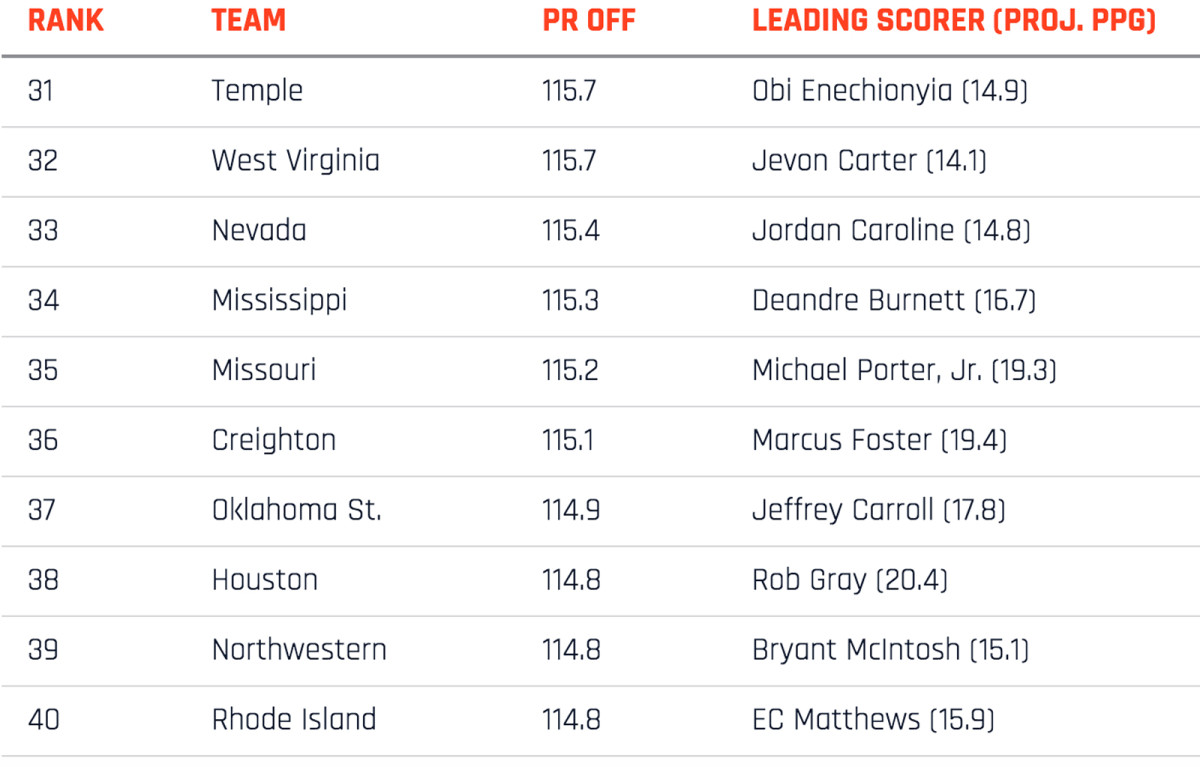
As has been the case in Morgantown the past four seasons, West Virginia (No. 32) is going to be more effective preventing opponents from putting the ball in the basket than doing it itself. That said, Jevon Carter could be primed for a stellar senior send-off after making a big leap in his offensive efficiency last season. Missouri (No. 35) should put the ball in Michael Porter Jr.’s hands and let him go to work, but this offense could fall flat in conference play if the supporting cast can’t pose enough threats elsewhere on the floor to draw defensive attention away from the RSCI’s No. 2 recruit. We have Oklahoma State (No. 37) finishing last in the Big 12, but that shouldn’t stop senior Jeffrey Carroll, who ranked second in the conference in offensive rating during conference play last season, from putting up really good scoring numbers.
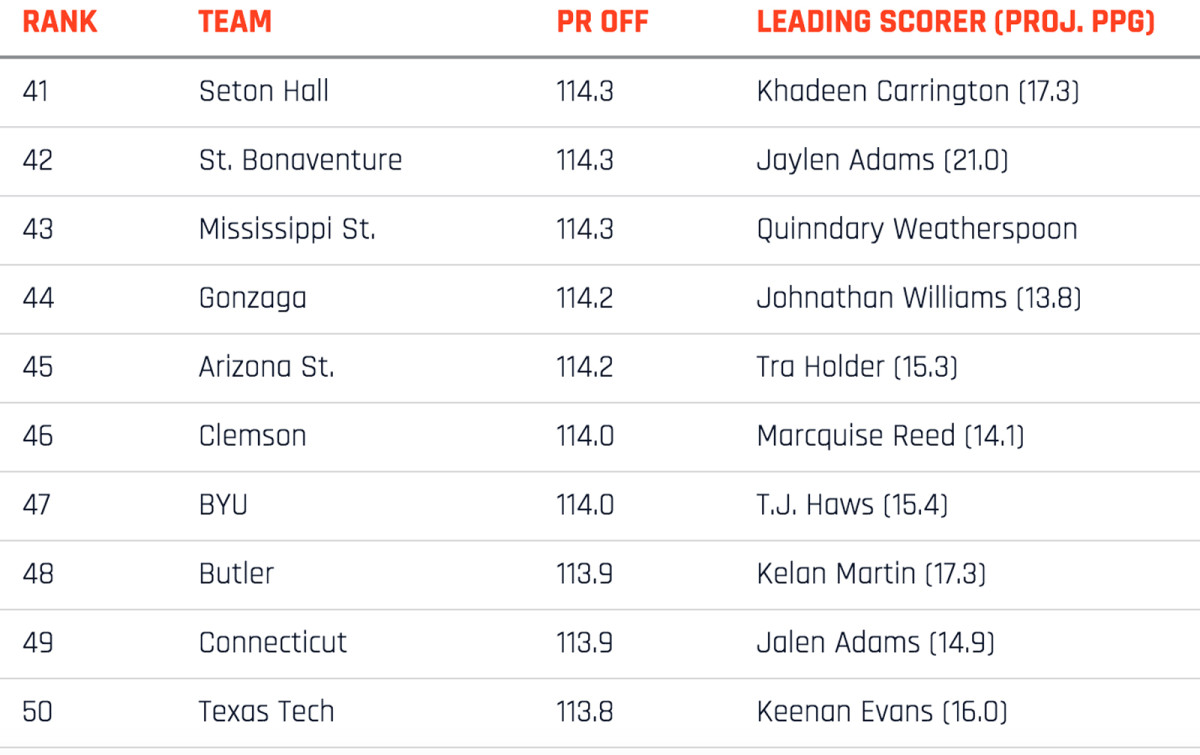
Angel Delgado is an offensive rebound-devouring low-block terror who’ll overwhelm the majority of Big East defenders he faces, and Seton Hall (No. 41) brings back two other players projected to average at least 15 points per game: senior guard Khadeen Carrington and senior forward Desi Rodriguez. Johnathan Williams will need to evolve from a complementary frontcourt piece into a go-to scorer for Gonzaga (No. 44), but two foreign-born sophomore forwards should lighten his offensive load: Rui Hachimura and Killian Tillie. Sophomore guard Kamar Baldwin drew more acclaim for his defense than his offense last season, but his capacity to increase his perimeter scoring output could be just as important for Butler (No. 48) in LaVall Jordan’s first season as head coach. Keenan Evans gives Texas Tech (No. 50) a potent threat from beyond the arc: He shot 43.2% on 118 attempts last season.
